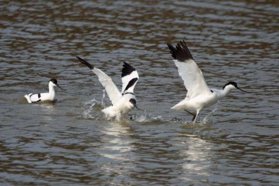Two's company, three's a crowd, four's a colony!
 A bird which made local wildlife history when it hatched chicks on Wearside for the very first time looks set to break another record at WWT Washington Wetland Centre.
A bird which made local wildlife history when it hatched chicks on Wearside for the very first time looks set to break another record at WWT Washington Wetland Centre.
The avocets as a trio, before the fourth arrived. Image courtesy of Ray Wilby. Four avocets have now been present on the centre’s Wader Lake for the past two weeks – a first in the site’s 36-year history.
One female is currently sitting on two eggs and, if the second pair nests successfully, WWT Washington will become home to the most northerly breeding avocet colony in the UK.
Avocets first nested at WWT Washington in 2006 and hatched two chicks that July, the most northerly UK hatching ever recorded at the time.
The striking black and white waders have bred successfully every spring since, and in April 2010 a second pair briefly appeared on the water but was soon chased off by the territorial original residents, which were already nesting.
This year however, both pairs appear to be settled and hopes are high that both will produce young.
Marketing manager Leanne McCormella said: “This is brilliant news and clearly demonstrates the importance of wetland habitat in supporting rare wildlife.
“Our staff and volunteers work very hard to maintain Wader Lake so that it is attractive to wading birds; for example, by creating mudflats rich in invertebrates for them to feed on and by suppressing vegetation on the islands using recycled Astroturf, to produce better potential nesting sites.
“The first avocet arrived on March 13 and one quickly became two, with the arrival of a second on March 15. They were then joined by a second male on March 24 and by March 30 the trio had become a foursome.
“Providing they have a successful nest, avocets become loyal to the same site for their entire lives, so hopefully this new pair will hatch healthy chicks and continue returning to WWT Washington for many years to come.”
The avocet was declared extinct as a breeding bird in the UK in 1842 but began to recover in 1947, colonising areas of wetland on the south and east coasts of England. The nearest breeding pairs to Wearside are in Teesside and Yorkshire, with fewer than 900 pairs in the UK.
The distinctive waders, with their elegant upwardly-curving beaks, are particularly renowned for their unique behaviour when, after copulation, the male puts one wing around the female and they run forward together with their bills crossed.
Visitors can watch the avocets from the four hides at Wader Lake and also via CCTV from Waterside Cafe.
Did you know?...
There are four species of avocet within the genus Recurvirostra – the pied, the American, the Andean and the Red-necked.
The avocets at WWT Washington are pied avocets or Recurvirostra avosetta, which translates as “with beak bent back”.
They swim and up-end like ducks to catch prey in their unusually curved beak; feeding on aquatic insects, larvae, crustaceans and worms.
Avocets nest in shallow scrape, with short pieces of stem, roots and leaves of marsh vegetation added to form the rim and lining. Clutches are usually of three to four eggs, with incubation taking 23 to 25 days. The fledgling period is 35 to 42 days.
The avocet is a Schedule 1 protected species and anybody convicted of taking, injuring or killing an avocet or damaging its nest, eggs or young faces a fine of up to £5,000 and/or six months in prison.
The avocet also features on the Amber List of UK birds of conservation concern, due to its localised distribution in Britain and elsewhere in Europe



